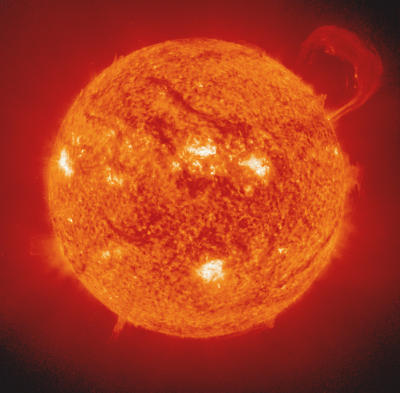Using AI to control energy for indoor agriculture
30 September 2024
Published online 11 May 2018
Gigantic swirls of solar plasma show that the sun has ‘planetary waves’ similar to those on Earth.

© Getty Images
The waves, called Rossby waves, naturally occur in rotating fluids. On Earth, they are found in the atmosphere and the oceans, and can stretch for hundreds of kilometres, contributing to the transfer of heat between the tropics and the poles.
They have so far been difficult to detect on the sun because their horizontal motions have very small velocities.
The scientists responsible for finding them, led by Laurent Gizon affiliated with New York University Abu Dhabi, said they followed the movement of ‘solar granules’ in six-years-worth of images taken by NASA’s Solar Dynamics Observatory spacecraft launched in 2010. These granules are what make the Sun’s surface look gritty in images. Each granule is about 1,500km in size and represents the top of a current that carries hot plasma to the surface and takes cooler plasma back into the sun’s interior.
The team used the granules to find the Rossby wave flows in a way similar to how corks could be used on the surface of water to detect large-scale currents. They found that the granules seen at the surface trace gigantic swirling motions, following the plasma flows caused by the Rossby waves.
Rossby waves were only found near the sun’s equator and move, as expected by theory, in the opposite direction of the sun’s rotation.
The sun’s kinetic energy is the energy it possesses by virtue of being in motion. The team found that the Rossby waves they detected contribute a full half of the sun’s large-scale kinetic energy, making them an essential component of solar dynamics, explains Gizon.
The study is, perhaps, the most comprehensive evidence that Rossby waves exist on the sun, since it involves direct measurement of the swirling motion of solar granules, according to astronomer Jeff Kuhn of the University of Hawaii’s Institute for Astronomy, who was not involved in the study.
In 2000, Kuhn and his colleagues reported the existence of 100-metre-high ‘hills’ on the sun’s surface, suggesting they were a probable surface manifestation of Rossby waves. Kuhn finds it puzzling, however, that Gizon and his team’s results imply that the sun and its plasma rotate all together at once, whereas it is known that the plasma around the equator rotates faster than that at the poles. “If these measurements are confirmed, we will learn new things about the Sun,” says Kuhn. “I expect their paper will stimulate a vigorous discussion that will soon make us all wiser about the solar interior,” says Kuhn.
Gizon and his team next aim to investigate what role these Rossby waves play in the Sun’s interior by studying solar seismic waves like those generated on Earth during earthquakes.
The Center for Space Science (CSS) at New York University Abu Dhabi, where Gizon is currently a research professor in addition to his position at Germany’s Max Planck Institute for Solar System Research, has a strong focus on analysing and interpreting space observations to learn about the Sun, stars and exoplanets, he explains.
The CSS is currently establishing a data centre for storing astrophysical observations from international space missions, including NASA’s Solar Dynamics Observatory. These observations will serve the United Arab Emirates’ scientific community, he says.
doi:10.1038/nmiddleeast.2018.54
Stay connected: